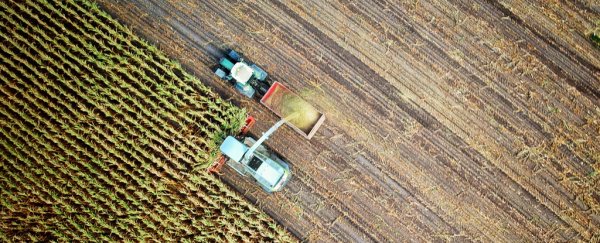Carbon dioxide and methane aren't the only greenhouse gases the world needs to worry about. The rapid rise of nitrous oxide (N2O), colloquially known as 'laughing gas', is no joke either.
This little-known greenhouse gas may not be as prevalent nor as long-lasting as carbon dioxide, but it is hundreds of times more potent and can stick around in the atmosphere for more than a century.
Today, it's released mainly through human agricultural practices, such as using cheap nitrogen fertiliser. And, as you've no doubt guessed, it's also a main contributor to ozone depletion and global warming.
To make matters worse, we've seriously underestimated its use. Since the turn of the century, new measurements reveal atmospheric N2O has risen much faster than experts at the United Nations once predicted.
"We see that the N2O emissions have increased considerably during the past two decades, but especially from 2009 onwards," says climate scientist Rona Thompson from the Norwegian Institute for Air Research (NILU).
"Our estimates show that the emission of N2O has increased faster over the last decade than estimated by the Intergovernmental Panel on Climate Change (IPCC) emission factor approach."
Instead of basing their calculations on human emissions, which are usually gathered from indirect sources, the researchers used a 'top-down' approach, based on dozens of atmospheric measurements from around the world. These data were then used to predict N2O dynamics on land and in the ocean between 1998 and 2016.
Unlike the simple model put forward by the IPCC in 2006, which assumed a linear relationship between N2O emissions and nitrogen use, the new findings suggest the issue could escalate quickly - more than it already has.
Between 2000 and 2005, and 2010 and 2015, N2O emissions were found to increase by roughly 10 percent. This is more than twice the rate estimated from fertiliser use, which was reported to the United Nations.
And this isn't due to natural changes, the authors say, but rather our growing reliance on nitrogen fertilisers for agricultural crops. Producing nitric acid and burning fossil fuels and biomass certainly doesn't help.
"This increase is significantly larger than prior estimates," the authors write, adding that "a change of this magnitude cannot be explained by any known mechanism through the [N2O] sink, as it would require an increase in atmospheric lifetime of ~20 years, and such a change is unrealistic over this timescale."
 (Thompson et al., Nature Climate Change, 2019)
(Thompson et al., Nature Climate Change, 2019)
The vast majority of the excess nitrogen is coming from the land, and while emissions in the United States and Europe have remained fairly stable, N2O has shot up in China and to a lesser extent in India, Nepal, Bangladesh, Pakistan and Brazil.
The authors found these regions are responsible for roughly half the increase in global emissions over the past two decades, with Africa contributing a further 20 percent. For both China and Brazil, the IPCC projections were way off.
"This mismatch seems to arise from the fact that emissions in those regions are proportionally higher than the use of nitrogen fertilisers and manure," explain the authors in a recent piece for The Conversation.
After a certain point, they explain, it appears as though plants can no longer fix nitrogen as effectively and this causes emissions to increase exponentially.
The idea is hardly new, but agricultural researcher Richard Eckard, who was not involved in the study, told ABC News Australia it's never been studied at this global level before.
"When you exceed the [plant] system's capacity to use that nitrogen fertiliser, the efficiency goes out the window, and the nitrogen can leak out of the cycle," he told the ABC.
"That plays out in some industries where the recommended amount of fertiliser is exceeded, and you get exponential loss of nitrogen."
In a Nature review of the study, environmental agronomist David Makowski agrees. He writes that the steady rise of nitrogen fertilisers in developing countries is most likely to blame for the recent spike in global emissions.
"This result reinforces the hypothesis of a nonlinear relationship between N2O emission and Nitrogen inputs and thus of a non-constant emission factor, as previously suggested by several experimental field studies and meta-analyses," he writes.
"This implies that the IPCC's default Tier 1 approach of a constant emission factor may both overestimate emissions when excess nitrogen is low and underestimate them when it is high."
IPCC reports have been critiqued in the past for underestimating carbon emissions from thawing permafrost, tipping points and positive feedback loops. Now, it's starting to look as though the same has occurred with N2O emissions.
Earlier this year, a study found that thawing permafrost in the Arctic may be releasing 12 times as much nitrous oxide as we previously thought. Even more recently, it's been suggested that global warming and ocean acidification may simply make emissions of this potent gas worse.
"We will have to adjust our emission inventories in light of these results," says Wilfried Winiwarter, a researcher at the IIASA Air Quality and Greenhouse Gases Program.
But more than that, the authors say we must reduce our emissions. In the USA and Europe, strong regulations have stopped nitrogen from building up in soils and in waterways, and more sustainable farming techniques in other parts of the world may help as well.
The authors suggest reducing the amount of soil tillage and waterlogging that occurs on farmed land - none of which come at the cost of agricultural output if done correctly.
"It's not that they shouldn't be using nitrogen fertiliser," Eckard told the ABC, "but if we all used the right amount we'd have significantly less nitrous oxide going into the atmosphere."
The study was published in Nature Climate Change.
